Rugby in Australia is a heck of a tough gig – for administrators, coaches and players alike.
Rugby Australia just about managed to keep its head above water in the Super Rugby Pacific 2022 power plays off the field with New Zealand. It insisted on a format that includes all five Australian sides and guarantees the presence of at least one of them in an eight-team playoff series.
It has been just as much of a struggle for Wallabies head coach Dave Rennie on the field. His charges have lost the three-match Bledisloe Cup by an average score of 23 points to 43. In the process, they have failed miserably to fulfil Rennie’s promise to make a point of holding their foes from across the Tasman to around 20 points per game.
The Wallabies have struggled with 15 players on the field against 15. Even more revealing is the deficit with Kiwis off the field on cards during the last two games.
The power play has been of no advantage to the Wallabies at all – far from it. They have conceded two converted tries while scoring no points of their own in a whole half hour of play.
Ardie Savea was dismissed for ten minutes in the second match, while Jordie Barrett rightly received a 20-minute red for his reckless high boot on Marika Koroibete in Perth. It made little or no difference to overall momentum.
At Optus stadium, Australia gave up three penalties, four other turnovers and one try to their adversaries with one man extra on the field.
Those 30 minutes will have concentrated Dave Rennie’s attention sharply on the black holes in Australia’s play. After the game, he re-emphasised the lack of balance between the running and kicking games.
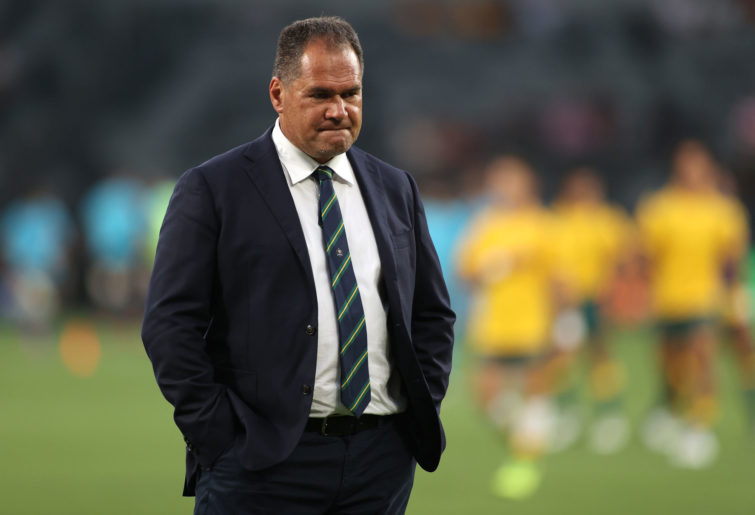
(Photo by Cameron Spencer/Getty Images)
“We’re really reluctant to kick,” the coach said.
“There’s times when it’s on to kick, we’ve squeezed them up, the [number] 15 is up and no one is covering in behind. We talk a lot about it. But I guess from a coaching perspective, we’ll keep driving it, to do a better job around our ability to play when it’s on to play and kick when it’s obvious.
“It’s an ability to play what’s in front of us. We’re not saying we’re not going to play. But often if you’ve gone three phases, and you haven’t gone forward, there maybe is some obvious kicking space, where you can put the pressure back on them. It’s an area where we need to be better.”
It was a rehash of his comments after a fluffed cross-kick by Hunter Paisami to Andrew Kellaway towards the end of the first summer Test against France.
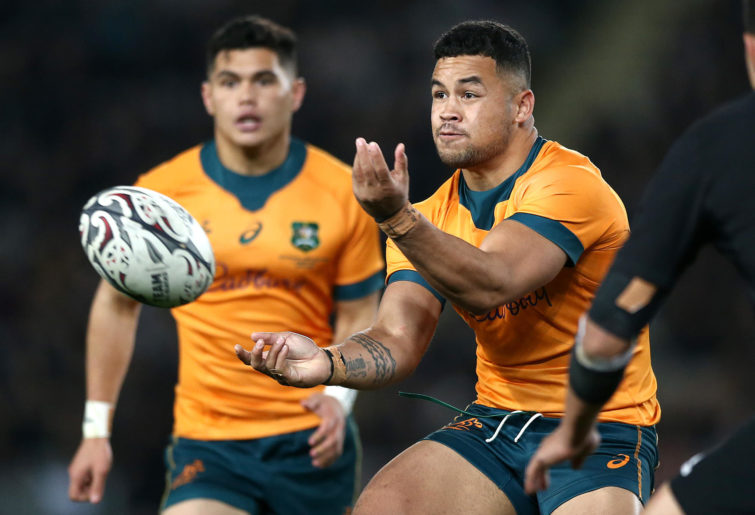
(Photo by Anthony Au-Yeung/Getty Images)
“We told [Paisami] – when he does the cross kick, to make it a bit shorter,” Rennie said.
“He’s got a pretty impressive kicking game. The confidence to drop it on the left foot but he’s actually a right-footer. I think a lot of people thought he was left-footed last year he kicked that many times of his left.
“We’re trying to grow our kicking game because it’s an important part of the game. I think we missed the opportunity to expose the French tonight with some smart kicks and maybe overplayed our hand so Hunter’s just playing what’s in front of him.”
Paisami’s kick looked like this.
Very much the right choice of play, but poor skill execution. If Kellaway is able to catch the ball, he must score. Fortunately, it did not cost the Wallabies the match, or for that matter, the series.
With the opposing number 15 off the field for 20 minutes, you would think the Wallabies would see the opportunities for their kicking game to flourish, right? Wrong.
Part of the problem lay in the initial selection at 9, 10 and 12. Tate McDermott, Noah Lolesio and Samu Kerevi are all cast from the same run-first mould. As I showed in last week’s article, one of Quade Cooper’s great strengths is his ability to vary his position and use the kick on attack. In Perth, that ability was entirely absent.
The red card sequence began, appropriately enough, with a missed penalty kick to touch by Tom Banks, aiming for the five-metre line but veering towards the in-goal instead.
Australia established their first attacking position off a strong cutback run by Kerevi five minutes later.
The first question for Australia’s game-managers to ask is: how will New Zealand defend the backfield with their fullback off the field?
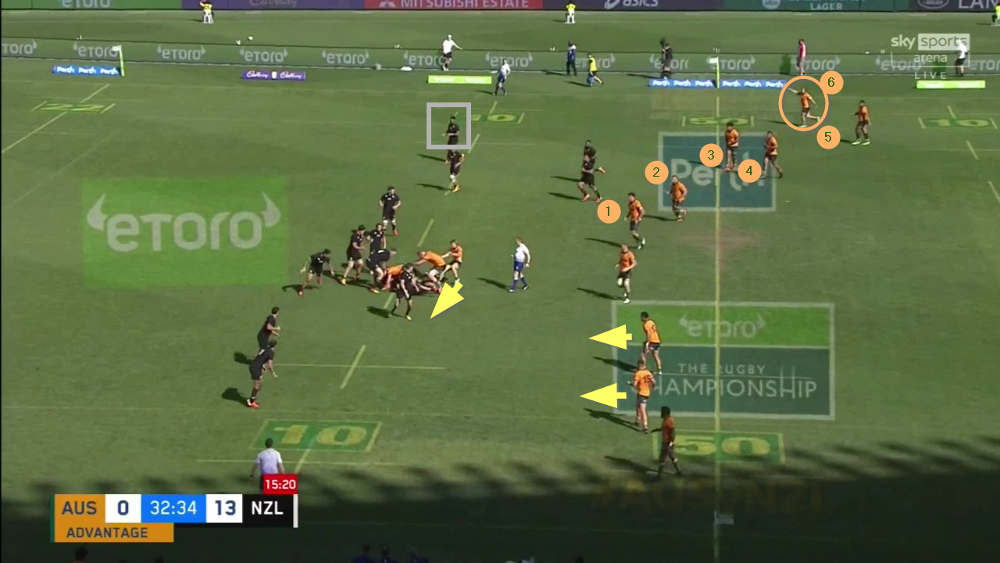
The answer is that they will keep 13 men in the line, with only Will Jordan (out of shot to the right) at the back. For the time being, a forward (number 6 Akira Ioane) is out on the left wing.
Michael Hooper has his arm out and can see the possibilities opening up, but McDermott and Lolesio choose to keep play in the middle of the paddock.
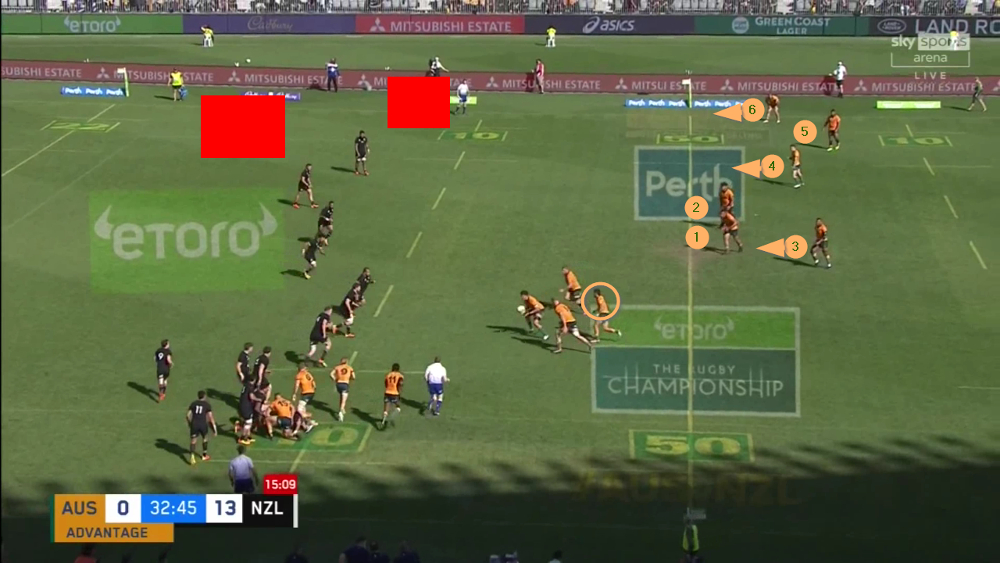
The space to target is outside and in behind Ioane, especially as two backs (Kerevi and Kellaway) have now joined Hooper. But Lolesio is playing so flat that there is no chance of him using a kick to exploit the vulnerable areas.
A couple of minutes later, the scenario was very much the same.
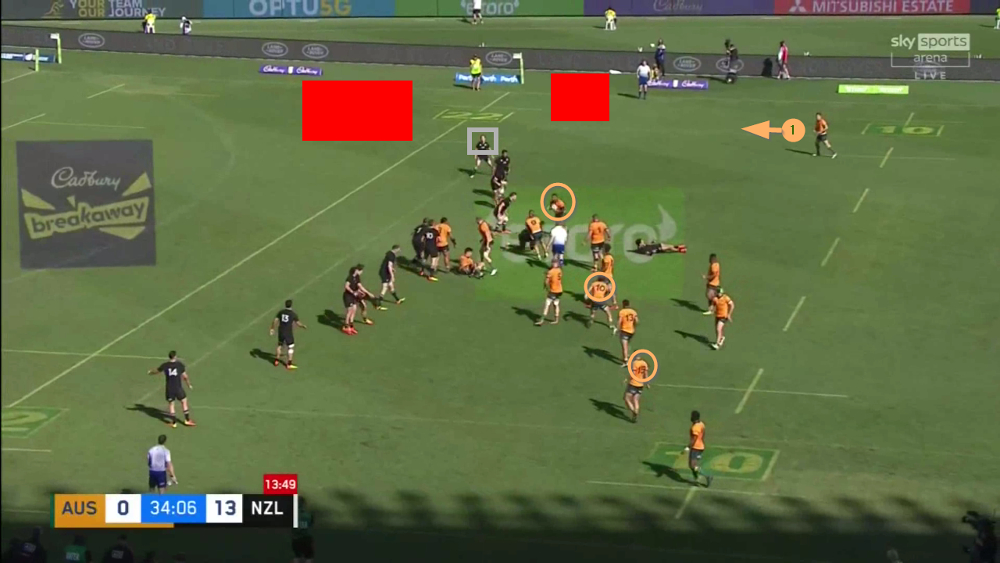
Kellaway is open for the kick outside or behind the last defender (scrumhalf Brad Weber), but Kerevi is coming short and Lolesio and Banks are stacked on the short-side.
The ball was only moved out to the right when the opportunity had evaporated, with a forward at first receiver (Darcy Swain), and Rieko Ioane back in position marking Kellaway.
A turnover is the inevitable outcome.
When Lolesio did choose to kick, it tended to be in situations where the odds were in the defence’s favour.
In the first example, he cross-kicks with the ball in the air for a long time and a competent defender (Anton Lienert-Brown) underneath it when it comes down. In the second, he kicks long when New Zealand have already dropped two defenders (Jordan and Ioane) into their backfield.
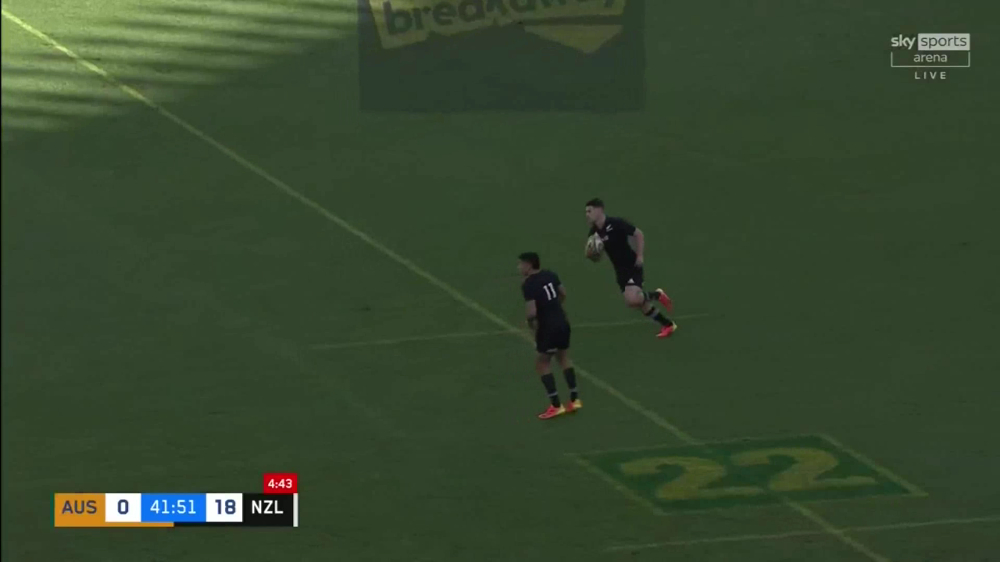
The outcome is that Jordan is able to kick beyond Tom Banks and force him into an ill-advised run out of his own in-goal area.
A couple of phases later, Tate McDermott’s box-kick exit was blocked down by Scott Barrett, and the Wallabies found themselves with their backs against the wall again.
Towards the end of Barrett’s red card, the Wallabies had another opportunity to launch an attack from a lineout in the New Zealand half.
With the All Blacks missing their number 15, it would probably have made more sense to call a longer line and pull as many forwards into the set-piece as possible, to stretch the spacings outside them.
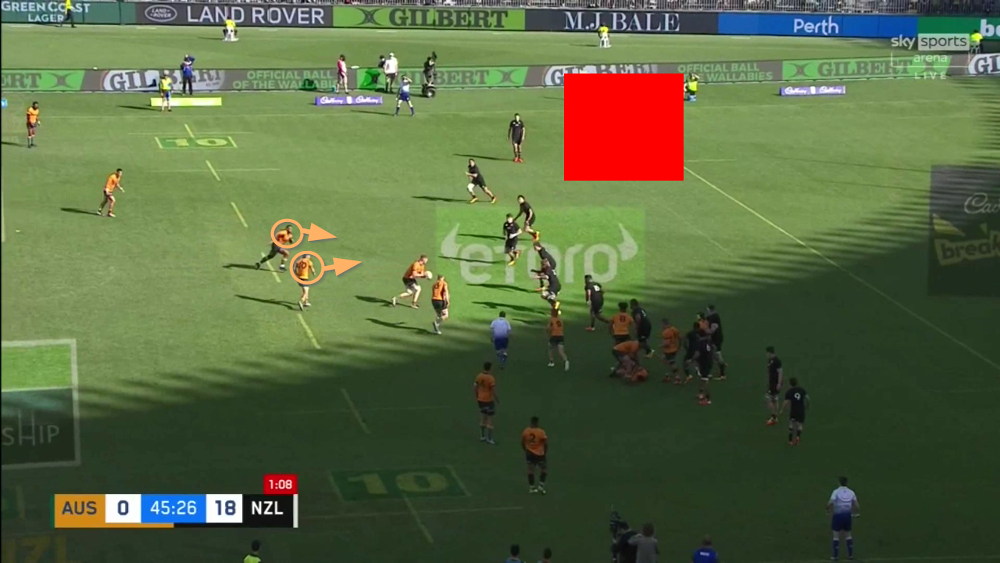
Rieko Ioane is nowhere in sight and there is space in behind Will Jordan, but Kerevi is on the end of a forward pod and Lolesio is too flat to make the kick.
By the time the Wallabies reach the left edge with ball in hand, the All Blacks have shuffled across and are ready to take it away from them.
The coup de grâce brings us full circle, and all the way back to a Tom Banks error.
A Kerevi offload creates a chance down the right for Australia, but Banks ignores the infield kick for Kellaway in favour of an option which should have been the last choice on his menu: a foot-race down the side-line with Kiwi flyer Rieko Ioane.
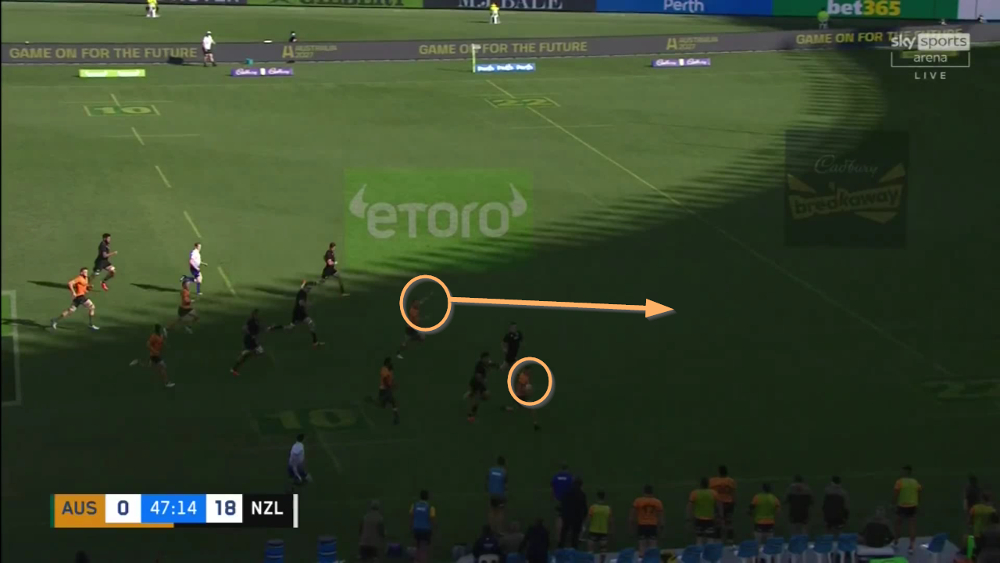
It earned him a finger-wagging of reproof from Rieko, but it should have earned him a red card from his own teammates too.
Summary
Off the field, Rugby Australia have just about managed to manufacture a competition for 2022 from which they can advance one of their under-strength professional franchises to the respectability of the playoffs.
But they are still losing most of the power plays with New Zealand, especially on the field itself. They have lost to an All Black team missing at least four or five of its top players, with the Kiwis down to 14 men for one whole quarter of the match, on home turf.
The Wallabies lost the 30-minute period with one player extra over the last two games by zero points to 14, and there is little sign of the yearned-for balance between run, kick and pass developing among the Wallaby game managers at 9, 10, 12 and 15.
Tate McDermott has been arguably Australia’s best attacking player during the Bledisloe Cup series – but if you pick Noah Lolesio at 10 and Samu Kerevi at 12, you need a Nic White at 9 to do the strategising and thinking, and most of the kicking.
Whatever else he might have done, for better or worse, Quade Cooper would have managed the attacking game better than young Noah Lolesio. At Perth, Australia badly needed a Quade to see the opportunities in the New Zealand backfield laid bare by Jordie Barrett’s red card.
If not Quade, then James O’Connor would have done very nicely. He cannot come back quickly enough. The good news is that there is still a good midfield there to be picked, with everyone fully fit and firing.
Whether it is McDermott-O’Connor-To’omua-Kerevi, or White-O’Connor-Kerevi-Paisami, there is ample material to work with at full strength.
With South Africa looming on the horizon over the next two weekends of the Rugby Championship, there will be plenty of unalloyed power plays to come. It may not be pretty, but Dave Rennie needs to find a win, any which way he can.




































































































